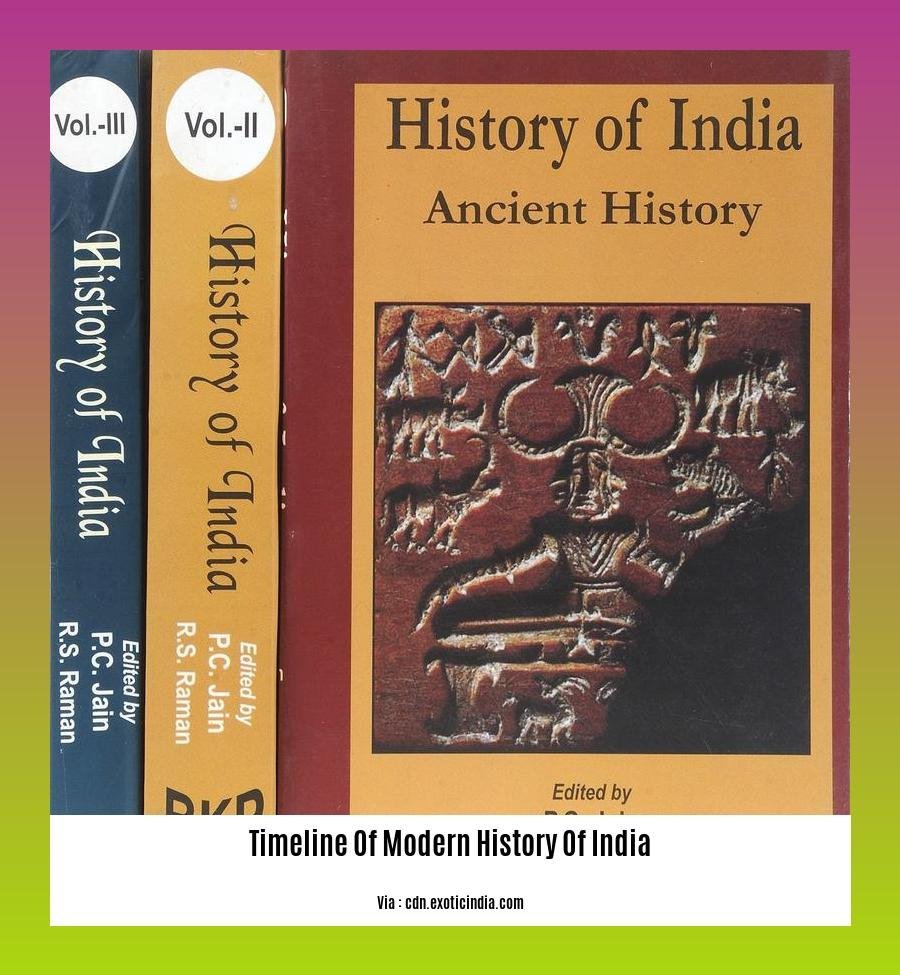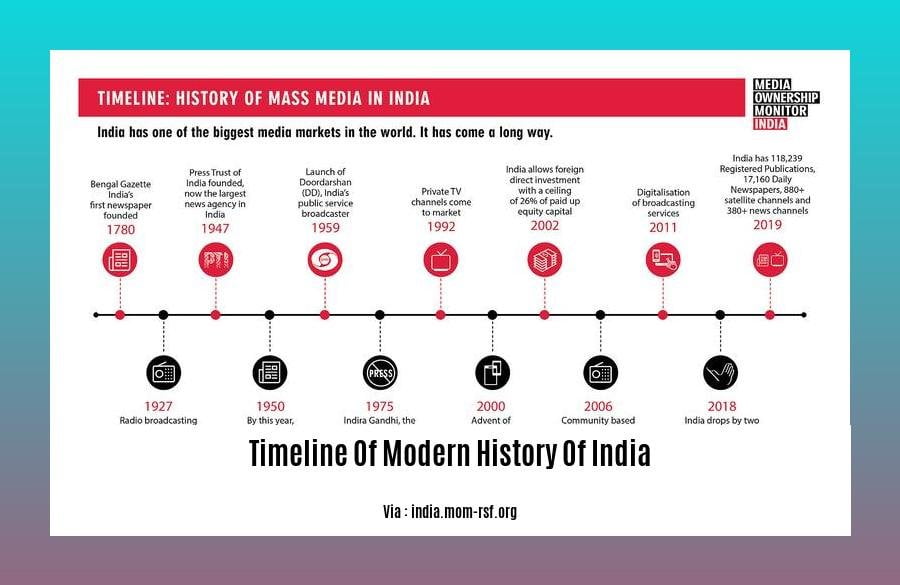Journey through the annals of time with “A Comprehensive Timeline of India’s Modern History: Key Milestones and Turning Points,” a captivating narrative that unveils the defining moments that have shaped the vibrant tapestry of modern India. From the dawn of independence to the rise of a global economic powerhouse, this timeline invites you to witness the profound transformations that have left an indelible mark on the nation’s destiny.
Key Takeaways:
-
India’s modern history features a timeline of significant events that have shaped the nation’s present.
-
The First War of Indian Independence in 1857 marked the initial struggle for freedom against British rule.
-
The Indian National Congress, founded in 1885, aimed to achieve Indian independence.
-
The Muslim League, established in 1906, sought to protect Muslim interests in India.
-
Mahatma Gandhi’s Non-Cooperation Movement in 1920 aimed to boycott British goods and institutions.
-
The Civil Disobedience Movement in 1930 targeted British Salt Laws through mass protest.
-
The Quit India Movement in 1942 demanded the end of British rule in India.
-
The Partition of India in 1947 led to the creation of India and Pakistan.
-
India’s constitutional development from 1946 to 1950 established the nation’s constitution and democratic government.
-
The India-China War in 1962 highlighted border disputes between India and China.
Timeline of Modern History of India

First War of Indian Independence (1857):
This conflict marked India’s initial fight for freedom against British rule, inspiring subsequent independence movements.
Formation of the Indian National Congress (1885):
Established by A.O. Hume, the Indian National Congress sought India’s independence through peaceful means and became a key player in the freedom struggle.
Formation of the Muslim League (1906):
The All-India Muslim League was formed to protect and advocate the political rights and interests of Indian Muslims, influencing the course of India’s political landscape.
Non-Cooperation Movement (1920):
Led by Mahatma Gandhi, this mass movement aimed to boycott British goods and institutions, marking a significant turning point in India’s freedom struggle and Gandhian philosophy.
Civil Disobedience Movement (1930):
Gandhi’s mass movement against the British Salt Laws called for Indians to break the salt monopoly by making their salt, leading to widespread civil disobedience and arrests.
Quit India Movement (1942):
The ‘Quit India’ resolution demanded an end to British rule in India, leading to the arrest of Mahatma Gandhi and other leaders and further intensifying the freedom movement.
Partition of India (1947):
The partition of India into two independent nations, India and Pakistan, was a pivotal event with far-reaching consequences, shaping the political and social landscape of the subcontinent.
Constitutional Development of India (1946-1950):
The Constituent Assembly of India drafted the Indian Constitution, which was adopted on January 26, 1950, establishing India as a sovereign democratic republic.
India-China War (1962):
The India-China War, also known as the Sino-Indian War, was a brief but significant conflict over territorial disputes along the Sino-Indian border.
-
Take a captivating journey through the history of Brazilian Jiu Jitsu to gain insights into its origins and evolution. the history of brazilian jiu jitsu
-
Explore the history of Nigeria from 1914 till date and discover the significant events that shaped its past.
-
Delve into the history of Nigeria from 1960 till date and gain an understanding of its post-independence journey.
-
Immerse yourself in the timeline of Indian history from 1600 to 1947 to explore the pivotal events that shaped the subcontinent.
The Nehru Era and the Building of a Socialist State
The tenure of India’s first and one of the longest-serving prime ministers, Jawaharlal Nehru, has had a profound impact on shaping the country’s contemporary fabric. His espousal of democratic socialism, industrialization, and non-aligned foreign policy has influenced India’s political, economic, and social landscape. Let’s explore the Nehru era:
Nehru’s Vision: Democratic Socialism
Nehru’s ideology, influenced by socialism and Fabianism, aimed to create an egalitarian society while maintaining democratic values. He believed in state control of key industries, land redistribution, and social welfare programs to uplift the marginalized. The Planning Commission, established in 1950, was instrumental in directing India’s economic development under five-year plans.
Industrialization and the Public Sector
Under Nehru’s leadership, India embarked on an ambitious industrialization drive. The public sector expanded rapidly, with the government establishing numerous state-owned enterprises in steel, heavy machinery, and other industries. These initiatives aimed to reduce India’s reliance on imports and foster self-sufficiency.
Non-Aligned Foreign Policy
Nehru played a pivotal role in the Non-Aligned Movement (NAM), a group of nations that sought to remain neutral during the Cold War power struggle. His advocacy for peaceful coexistence and عدم الانحياز (non-alignment) earned India global recognition and respect.
Challenges and Criticisms
Despite Nehru’s achievements, his policies faced challenges and criticism. The pace of industrialization was deemed slow by some, and the public sector’s inefficiencies became evident. Additionally, the socialist policies were criticized for stifling private sector growth and innovation.
Key Takeaways:
-
Nehru’s ideology of democratic socialism shaped India’s economic and social policies, emphasizing state control, land redistribution, and social welfare.
-
Nehru’s industrialization drive aimed to reduce India’s reliance on imports and promote self-sufficiency through the growth of the public sector.
-
Nehru’s non-aligned foreign policy advocated for peaceful coexistence and عدم الانحياز (non-alignment), earning India global recognition.
-
Nehru’s policies faced challenges, including critiques of the pace of industrialization and the inefficiencies of the public sector.
-
Nehru’s legacy remains significant as his policies laid the foundation for India’s modern political and economic development.
Sources:
Nehru Era
The Green Revolution and the Transformation of Indian Agriculture

The Green Revolution in India, initiated in the 1960s, was a colossal transformation that catapulted traditional agriculture into a modern, industrialized system. This epoch-making event not only boosted food production, making India self-sufficient in food grains, but also triggered far-reaching social and economic changes.
Key Milestones and Turning Points
-
Introduction of High-Yielding Variety (HYV) Seeds:
The introduction of HYV seeds, scientifically engineered for higher yields, was a game-changer. These seeds, coupled with improved irrigation methods and fertilizers, dramatically increased crop productivity. -
Mechanization of Agriculture:
The Green Revolution ushered in the era of mechanized farming, replacing traditional manual labor with tractors, threshers, and other farm machinery. This not only increased efficiency but also reduced drudgery and improved productivity. -
Expansion of Irrigation Facilities:
The Green Revolution was fueled by the expansion of irrigation facilities, such as canals, dams, and tube wells. This ensured a reliable water supply, enabling farmers to cultivate crops even in drought-prone areas. -
Increased Use of Fertilizers and Pesticides:
The Green Revolution saw a surge in the use of chemical fertilizers and pesticides, which further boosted crop yields. However, this also raised concerns about their long-term environmental impact. -
Role of Scientists and Institutions:
The success of the Green Revolution can be attributed to the dedication of visionary scientists like M. S. Swaminathan, often referred to as the “Father of the Green Revolution in India.” Institutions like the Indian Agricultural Research Institute (IARI) and the International Rice Research Institute (IRRI) played a pivotal role in developing HYV seeds and disseminating knowledge.
Key Takeaways:
- The Green Revolution transformed traditional Indian agriculture into a modern, industrialized system.
- Introduction of HYV seeds, mechanized farming, irrigation facilities, and fertilizers revolutionized crop production.
- The Green Revolution made India self-sufficient in food grains, alleviating chronic food shortages.
- Concerns about the environmental impact of chemical fertilizers and pesticides emerged.
Sources:
- Green Revolution in India
- The Green Revolution in India: A Case Study
Economic Reforms and the Rise of Modern India
In 1991, India embarked on a transformative journey of liberalization and economic reforms, shedding its socialist shackles and embracing the global market. Economic Reforms and the Rise of Modern India marked a pivotal shift that reshaped the nation’s economic landscape.
Key Takeaways:
- India’s economic reforms, initiated in 1991, aimed to liberalize the economy by dismantling socialist policies and opening up to market forces.
- The reforms included deregulation, privatization, and the dismantling of trade barriers, resulting in rapid economic growth and the emergence of India as a global economic powerhouse.
- Despite the successes of economic reforms, challenges remain, such as poverty, inequality, and a large informal economy.
- India’s government is committed to addressing these challenges through various initiatives aimed at promoting inclusive growth and development.
A Paradigm Shift: Embracing Market Forces
India’s economic reforms were a bold departure from the socialist policies that had stifled growth and innovation for decades. The government’s decision to dismantle the License Raj, a complex system of permits and regulations that hindered private sector activity, unleashed a wave of entrepreneurial energy.
Foreign investment and trade barriers were dismantled, allowing Indian businesses to compete on a global scale and integrate with the international economy. The privatization of state-owned enterprises infused competition and efficiency into key sectors, leading to improved productivity and service delivery.
The Fruits of Reform: A Resurgent Economy
The economic reforms bore fruit quickly, transforming India into one of the fastest-growing major economies in the world. The country’s GDP surged, driven by a vibrant private sector and increased global trade.
New industries emerged, and existing ones flourished, creating jobs and opportunities for millions of Indians. The reforms also led to a significant reduction in poverty and an expansion of the middle class.
Challenges Ahead: Addressing Inequality and Building an Inclusive Society
Despite the remarkable success of India’s economic reforms, challenges persist. Poverty and inequality remain significant concerns, with a large segment of the population still living in challenging conditions.
The informal economy, characterized by low productivity and limited access to formal employment, continues to be a significant challenge. Addressing these issues requires sustained efforts to promote inclusive growth, create decent jobs, and expand social safety nets.
Government Initiatives: Paving the Way for a Brighter Future
India’s government has recognized the need to address these challenges and has initiated several programs and policies to promote inclusive growth and sustainable development.
Investments in education and skill development aim to enhance the employability of the workforce and reduce the skills gap. Financial inclusion initiatives seek to bring banking services to the unbanked, empowering them to participate in the formal economy.
Efforts to improve the regulatory environment, develop infrastructure, and combat corruption are also underway. These initiatives reflect the government’s commitment to creating a more equitable and prosperous society for all Indians.
Conclusion: A Journey of Transformation
India’s economic reforms, initiated in 1991, have transformed the country into a global economic powerhouse. While challenges remain, the government’s commitment to inclusive growth and sustainable development is a testament to its determination to build a brighter future for all Indians.
Citations:
– Twenty-Five Years of Indian Economic Reform
– Economic Reforms in India Since 1991: Impact, Challenges, and the Way Forward
FAQ
Q1: What major event marked India’s first significant struggle for independence against British colonial rule?
A1: The First War of Indian Independence in 1857 stands as the first notable uprising against British colonial rule, showcasing the determination of Indians to gain freedom.
Q2: Which organization played a pivotal role in advocating for India’s independence from British rule?
A2: The Indian National Congress, established in 1885 under the leadership of A.O. Hume, became a prominent force in the struggle for Indian independence, demanding self-governance and the end of colonial rule.
Q3: What was the significance of the Partition of India in 1947?
A3: The Partition of India in 1947 resulted in the creation of two independent nations: India and Pakistan. This division was a defining moment in modern Indian history, marking the culmination of the freedom struggle and the emergence of two distinct nations.
Q4: How did the Green Revolution impact India’s agricultural sector?
A4: The Green Revolution in the 1960s transformed India’s traditional agricultural practices into a modern, industrial system. It involved the introduction of high-yielding variety seeds, mechanized farm tools, irrigation facilities, and fertilizers, leading to increased productivity and self-sufficiency in food production.
Q5: What were the key economic reforms implemented in India since 1991, and what was their impact?
A5: In 1991, India initiated significant economic reforms, transitioning from a centrally planned economy to a market-driven one. These reforms included the removal of restrictions on foreign investment and trade, privatization of state-owned enterprises, and the deregulation of industries. These changes led to India’s economic growth and transformation into the third-largest economy in the world by purchasing power parity.
- Unveiling Bernhard Caesar Einstein’s Scientific Achievements: A Legacy in Engineering - July 15, 2025
- Uncover who is Jerry McSorley: CEO, Family Man, Business Success Story - July 15, 2025
- Discover Bernhard Caesar Einstein’s Scientific Contributions: Unveiling a Legacy Beyond Einstein - July 15, 2025















